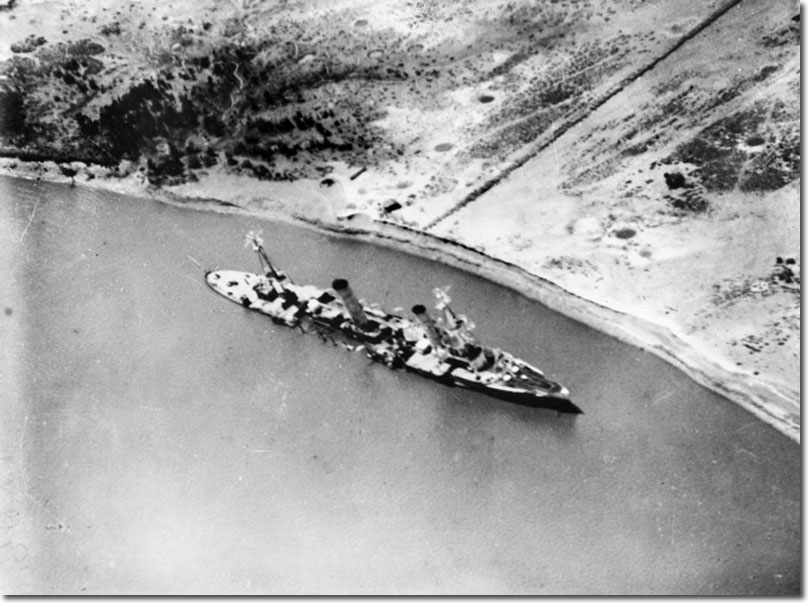|
|

 |
|
In 1914, the most powerful German ship in the Indian Ocean was the light cruiser Königsberg. After an engine failure following her sinking of the British protected cruiser HMS Pegasus, Königsberg—along with her supply ship Somali—sought refuge in the delta of the Rufiji River in order to hide while her damaged machinery was transported overland to Dar es Salaam for repair. The British cruiser HM Chatham discovered Königsberg in the delta towards the end of October. On 5 November, two additional British cruisers—HMS Dartmouth and Weymouth—arrived at the scene, and blockaded the German ship in the delta. In early November, Chatham opened fire at long range and set fire to Somali, but she failed to hit Königsberg, which promptly moved further upstream. The British ships were more powerful than Königsberg, but were unable to navigate the delta. The crew of Königsberg camouflaged their ship so it looked like the forest around the delta.
The British made several attempts to sink Königsberg including one to slip a shallow-draught torpedo boat (with escorts) within range, an operation easily repulsed by the force in the delta. A blockship—the Newbridge—was successfully sunk by the British across one of the delta mouths to prevent her escape; however, it was soon realized that Königsberg could still escape through one of the delta's other channels. Dummy mines were laid in some of these alternates, but they were considered a doubtful deterrent. A civilian pilot named Cutler was hired to bring his Curtiss seaplane for reconnaissance; his plane was shot down, although they verified the presence of the elusive cruiser. A pair of Royal Naval Air Service Sopwith seaplanes were brought up with the intention of scouting and even bombing the ship, but they soon fell apart in the tropical conditions. A trio of Short seaplanes fared a little better, managing to take photographs of the ship before they were grounded by the glue-melting tropical heat and German fire. Attempts to use the 12 in (300 mm) guns of the old battleship HMS Goliath to sink the cruiser were unsuccessful, once again because the shallow waters prevented the battleship getting within range. However, by March 1915 food supplies were low and many of the crew members aboard the Königsberg had died from malaria and other tropical diseases. Generally cut off from the outside world, the morale of the sailors fell. However, the situation was marginally improved with a scheme to resupply the ship and give her a fighting chance to return home. A captured British merchant ship—Rubens—was renamed Kronborg and given a Danish flag, papers, and a crew of German sailors specially selected for their ability to speak Danish. She was then loaded with coal, field guns, ammunition, fresh water, and supplies. After successfully infiltrating the waters of East Africa, she was intercepted by the alerted HMS Hyacinth, which chased her to Manza Bay. The trapped ship was set on fire by the crew and left. The Germans later salvaged much of her cargo which went on to be used in the land campaign and some transported to the Königsberg. Two shallow-draught monitors—HMS Mersey and Severn—were towed to the Rufiji from Malta by the Red Sea making it to the delta in June 1915. With nonessential items removed, added armour bolted on, and covered by a full bombardment from the rest of the fleet, they ran the gauntlet. Aided by a squadron of four land planes—two Caudrons and two Henry Farmans - based at Mafia Island to spot the fall of shells, they engaged in a long-range duel with Königsberg, which was assisted by shore-based spotters. Although Mersey was hit and the monitors were unable to score on the first day, they returned again on 11 July. Finally, their 6 in (150 mm) guns knocked out Königsberg's armament and then reduced her to a wreck. At around 14:00, Looff ordered her scuttled with a torpedo. After the battle, the British were unquestionably the strongest naval power in the Indian Ocean, although the sailors who managed to escape provided a welcome infusion of manpower into the German East African forces. |
Naval Action on Lake Tanganyika Article
Armed Forces | Art and Culture | Articles | Biographies | Colonies | Discussion | Glossary | Home | Library | Links | Map Room | Sources and Media | Science and Technology | Search | Student Zone | Timelines | TV & Film | Wargames